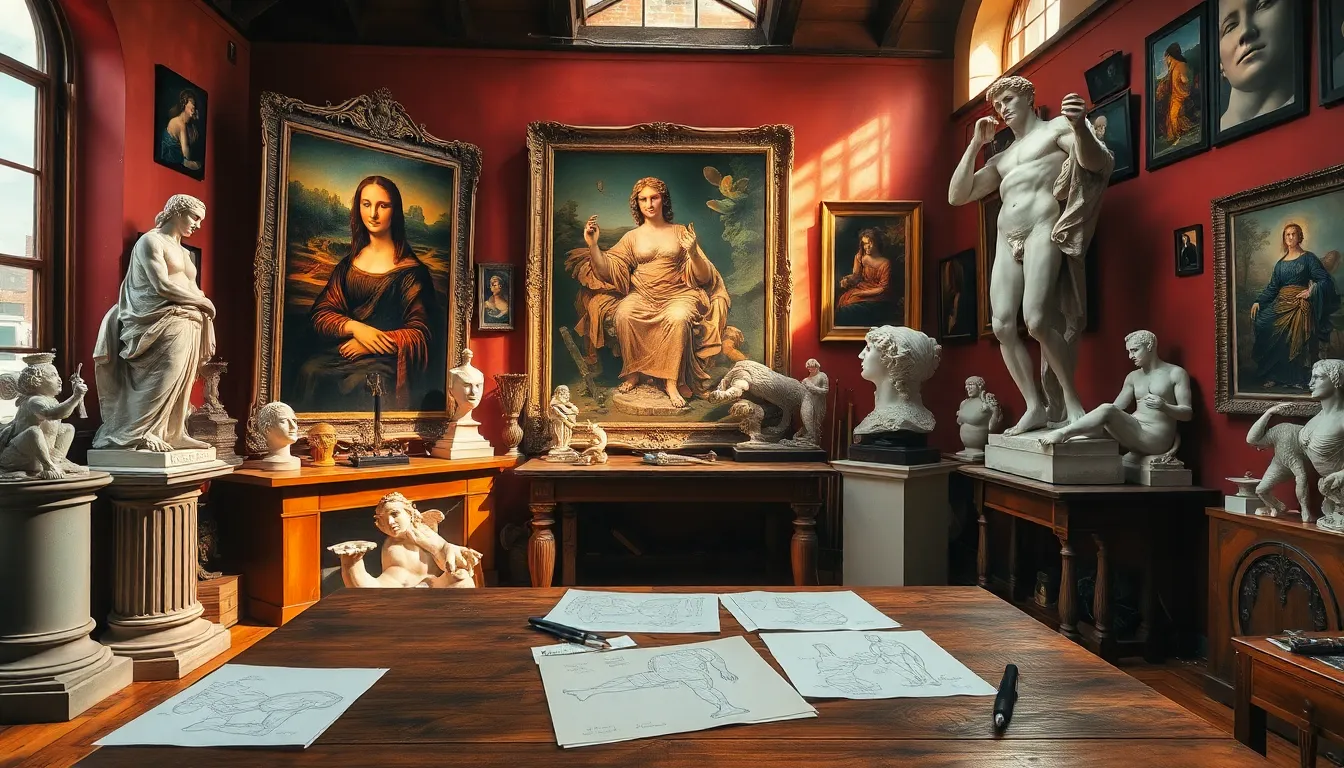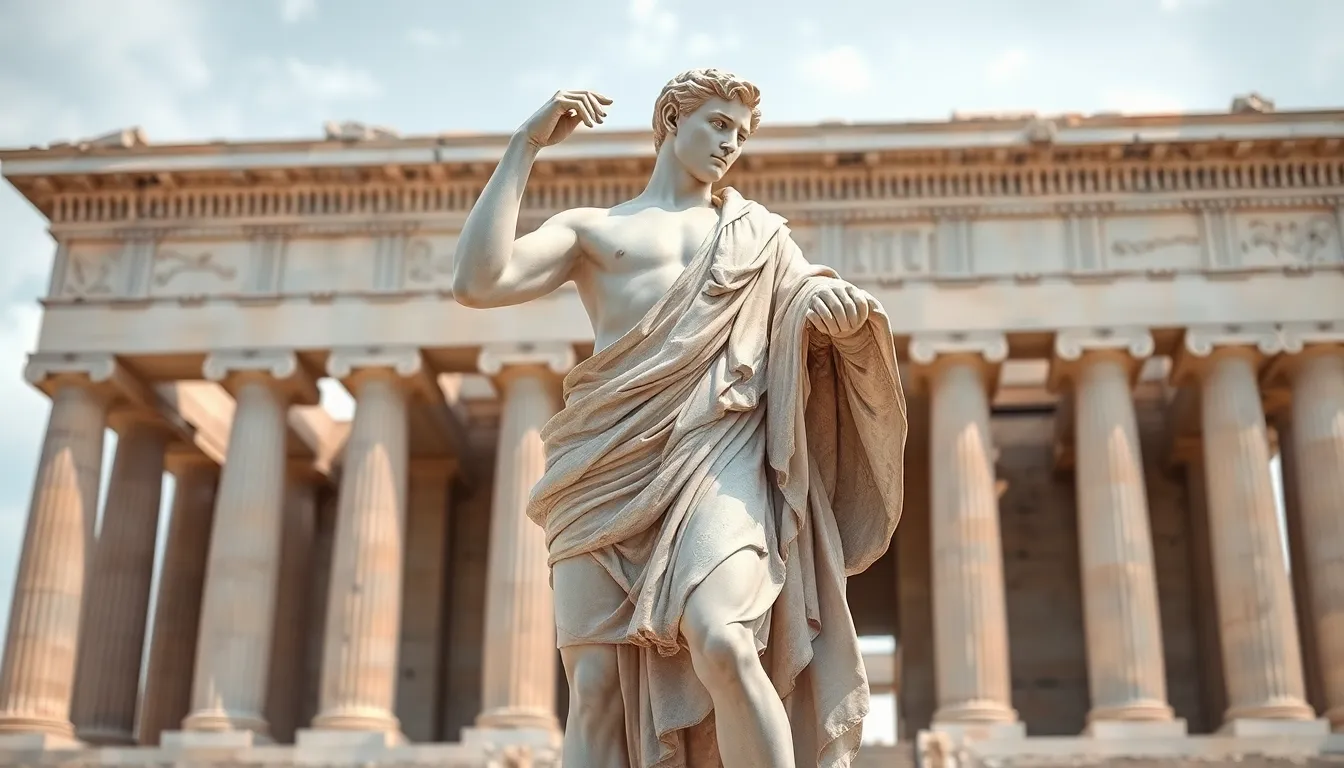The Renaissance was a remarkable period that transformed art, culture, and thought in Europe. This era birthed some of the most celebrated artists in history, whose masterpieces continue to inspire and captivate audiences today. From the striking realism of Leonardo da Vinci to the vibrant colors of Raphael, these Renaissance masters revolutionized artistic expression and set the stage for future generations.
Exploring the lives and works of these iconic figures reveals not just their technical prowess but also their profound impact on society. Each artist brought a unique perspective, blending science, philosophy, and creativity in ways that challenged the status quo. As we delve into the world of Renaissance masters, we uncover the genius behind their creations and the enduring legacy they left behind.
Table of Contents
ToggleOverview of Renaissance Masters
Renaissance masters represent a pivotal moment in art history, showcasing the integration of scientific observation, human emotion, and classical themes. Artists such as Leonardo da Vinci, Michelangelo, and Raphael played crucial roles in shaping artistic methods that emphasized realism and anatomical precision.
Key Artists
- Leonardo da Vinci: Known for masterpieces like the “Mona Lisa” and “The Last Supper,” Da Vinci showcased innovative techniques in perspective and chiaroscuro. His studies in anatomy and natural sciences informed his artistic practice, bridging art and science.
- Michelangelo Buonarroti: Celebrated for his sculptural works, including “David” and the “Pietà,” Michelangelo’s mastery extended to painting, evident in the Sistine Chapel ceiling. His ability to convey human emotion in stone set new standards for artistic expression.
- Raphael Sanzio: Renowned for his harmonious compositions, Raphael’s works like “The School of Athens” reflect classical influences and an understanding of space and perspective. His portraits captured human beauty and grace, making him a pivotal figure in Renaissance art.
Contributions to Art and Culture
Renaissance masters contributed significantly to the rebirth of classical antiquity, emphasizing proportion, symmetry, and balance in their work. They engaged in the study of human anatomy, perspective, and light, resulting in lifelike representations unprecedented in earlier periods. Their collective impact fostered a cultural environment that encouraged exploration and innovation across disciplines, influencing art, architecture, and literature.
Lasting Legacy
The Renaissance masters left an indelible mark on art history, inspiring generations of artists and thinkers. Their techniques and philosophies continue to resonate, reinforcing the value of art as a means of intellectual and emotional expression. Today, their works remain vital studies for artists and scholars alike, ensuring their relevance in contemporary culture.
Key Figures in the Renaissance

Renaissance masters profoundly shaped art and culture, each contributing uniquely to the movement. Key figures include Leonardo da Vinci, Michelangelo, and Raphael, renowned for their innovative techniques and lasting influence.
Leonardo da Vinci
Leonardo da Vinci exemplified the Renaissance spirit through his diverse talents as an artist, scientist, and inventor. He produced iconic works like the “Mona Lisa” and “The Last Supper,” showcasing mastery in perspective and chiaroscuro. His systematic studies of human anatomy led to realistic portrayals, while his meticulous observations of nature enhanced the accuracy of his compositions. Da Vinci’s notebooks reveal a mind that interconnected art and science, pioneering ideas that continue to inspire.
Michelangelo
Michelangelo Buonarroti, a sculptor and painter, emphasized the beauty of the human form. His sculptures, including “David” and the “Pietà,” displayed exceptional anatomical precision and emotional depth. His work on the Sistine Chapel ceiling, featuring scenes like the “Creation of Adam,” demonstrated his ability to blend narrative with powerful imagery. Michelangelo’s artistic innovations transformed traditional techniques, setting new standards for expression and proportion that reverberated through art history.
Raphael
Raphael, known for his serene and harmonious compositions, effectively integrated classical themes into his art. His masterpiece, “The School of Athens,” illustrates a gathering of great thinkers, showcasing his skill in perspective and spatial arrangement. Raphael’s ability to convey clarity and balance in his works set him apart, making him a pivotal figure in Renaissance art. His contributions influenced generations, combining beauty with intellectual thought in ways that resonated throughout Western art.
Artistic Techniques of the Renaissance Masters
Renaissance masters utilized groundbreaking artistic techniques that revolutionized visual representation. Their methods established a foundation for future artwork, focusing on realism and emotional depth.
Use of Perspective
Perspective played a crucial role in Renaissance art, allowing artists to create the illusion of depth and three-dimensional space. Linear perspective, developed by theorists like Filippo Brunelleschi, employed a vanishing point on the horizon line. This technique enabled artists to arrange objects in relation to one another, creating a realistic portrayal of architectural spaces and landscapes. Works such as Leonardo da Vinci’s “The Last Supper” and Raphael’s “The School of Athens” exemplify the effective use of one-point perspective to enhance spatial relationships. Artists also experimented with atmospheric perspective, which softened distant elements to create a sense of depth.
Color and Light
Renaissance masters also advanced the use of color and light in their artwork. Chiaroscuro, the contrast between light and shadow, allowed for greater emotional expression and depth. Leonardo da Vinci mastered this technique, using it to model forms and highlight the human figure, as seen in the “Mona Lisa.” Sfumato, another method popularized by da Vinci, blended colors and tones seamlessly for soft transitions, further enhancing realism. Additionally, artists like Caravaggio employed tenebrism, an extreme contrast of light and dark, to create dramatic effects and draw attention to focal points in their paintings, evoking intense emotions.
Influence on Modern Art
Renaissance masters profoundly shaped the trajectory of modern art through their innovative techniques and conceptual frameworks. Their approach emphasized realism, anatomical accuracy, and emotional depth, laying the groundwork for future artistic movements.
Techniques and Innovations
- Realism: Renaissance artists pioneered techniques that captured lifelike representations. Methods such as chiaroscuro and sfumato provided nuanced lighting and shadow, influencing contemporary realism in art.
- Perspective: The introduction of linear perspective revolutionized spatial representation. This technique allowed artists to create depth and dimension, impacting modern architectural and landscape painting.
- Emotional Expression: The focus on human emotion transformed how artists approached their subjects. Modern artists continue to draw from this emotional depth to convey complex feelings.
Legacy and Inspiration
- Continued Exploration: The Renaissance spirit of inquiry encourages modern artists to explore diverse themes and techniques. This exploration fosters innovation across artistic disciplines.
- Influence on Movements: Subsequent art movements, including Baroque, Impressionism, and Surrealism, draw upon the foundations laid by Renaissance masters. Elements of their work resurface in contemporary art practices.
- Cultural Dialogue: The dialogue between Renaissance art and modern interpretations creates a richer, multifaceted understanding of culture. Artists frequently reference Renaissance tropes to bridge historical and contemporary contexts.
The enduring influence of Renaissance masters manifests in countless ways, from techniques that shape contemporary practices to philosophical inquiries that challenge perceptions of art and reality. Their legacy remains vital in the ongoing evolution of artistic expression.
The Renaissance masters fundamentally reshaped the landscape of art and culture. Their innovative techniques and profound understanding of human emotion and anatomy continue to inspire artists today. By blending science and creativity they not only pushed artistic boundaries but also fostered a spirit of inquiry that remains essential in contemporary art.
The legacy of figures like Leonardo da Vinci, Michelangelo, and Raphael transcends time and continues to influence various artistic movements. Their work serves as a testament to the power of creativity in shaping human thought and expression. As modern artists explore new themes and techniques they carry forward the Renaissance spirit, ensuring that the impact of these masters endures for generations to come.





